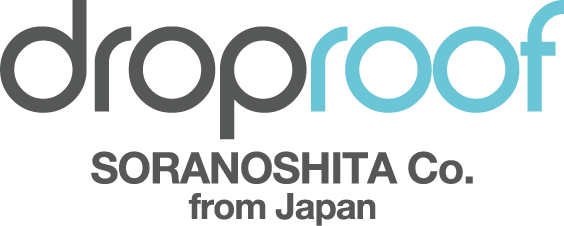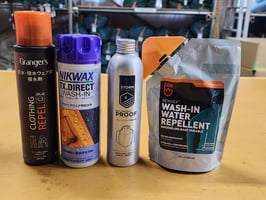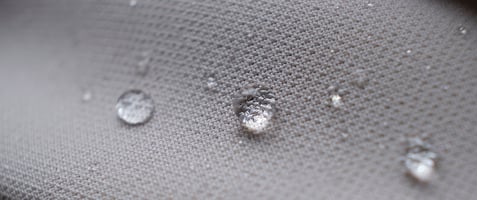From Home Hacks to Factory Finishes: Comparing DIY DWR Reactivation and Factory-processed Clothing
Are you tired of your waterproof outdoor gear losing its water-repellency? You will be surprised! In this article, we will explain the difference between DIY hacks, which are solutions for reviving durable water repellent (DWR) finishes on gear, and factory-processed DWR, which was originally manufactured as clothing.
When it comes to maintaining the water-resistance of your clothing and gear, DIY hacks like homemade DWR sprays and wash-in treatments have gained popularity. But how do these homemade solutions compare to factory processed DWR?
In this comparison, we will delve into the effectiveness, longevity, and convenience of both approaches. We will also consider factors like cost, environmental impact, and ease of application.
Whether you're an outdoor enthusiast looking to maximize the lifespan of your gear or a fashion-conscious individual who wants to keep their clothes water- repellent, this article will provide you with valuable insights and guidance. So, if you're ready to uncover the truth behind DIY DWR reactivation versus factory-processed clothing, let's dive in!
What is DWR and why is it important?
Durable Water Repellent (DWR) treatment is a chemical treatment applied to outdoor clothing and gear to make them water repellent. This treatment creates a hydrophobic layer in the fabric's fabric that allows water to roll off in balls rather than soak into the fabric. DWR is essential because it helps to keep you dry and comfortable in wet conditions, preventing the fabric from becoming saturated and losing its insulating properties.
DWR is commonly found on jackets, pants, gloves, and other outdoor gear. It is especially important for outdoor enthusiasts who regularly engage in activities like hiking, camping, skiing, and mountaineering. Without a functioning DWR finish, gear becomes waterlogged, heavier, more susceptible to temperature loss, and less effective at protecting against wind and rain.
So, whether you're planning a multi-day backpacking trip or simply want to stay dry during a rainy commute, maintaining the effectiveness of your gear's DWR finish is crucial. In the following sections, we will explore different methods for reactivating DWR, comparing do-it-yourself (DIY) hacks to factory-processed options.
DIY methods for reactivating DWR on outdoor clothing
DIY enthusiasts have come up with various methods for reactivating the DWR on their outdoor clothing. One popular approach is using homemade DWR sprays. These sprays typically consist of a mixture of solvent and DWR reactivation solution. The user sprays the mixture onto their clothing, ensuring even coverage, and then allows it to air dry.
Another DIY method involves washing your gear with a specialized DWR reactivating detergent. These detergents are designed to replenish the DWR finish during the washing process. Simply follow the instructions on the detergent packaging, ensuring to set your washing machine to the appropriate settings for outdoor gear.
Additionally, some DIY enthusiasts have experimented with applying heat to their gear to reactivate the DWR. These are actually effective, using a hair dryer or iron to heat the fabric and energize the DWR process to reactivate it. However, caution must be exercised when using heat, as excessive heat can damage or melt certain types of fabrics.
While these DIY methods may seem convenient and cost-effective, it is important to consider its effectiveness and longevity compared to factory-fabricated DWR. Let's explore the pros and cons of DIY DWR reactivation in the next section.
Pros and cons of DIY DWR reactivation
DIY DWR reactivation methods certainly have their advantages. First and foremost, they offer a lower cost alternative to factory-processed options. Homemade sprays and wash-in treatments can be made using readily available household ingredients, saving you money in the short term.
The DIY method is also highly convenient because it allows the reactivation process to be performed at home without sending tools or hiring a specialist. This is particularly beneficial for outdoor enthusiasts who prefer to maintain their gear themselves and avoid the hassle of outsourcing the reactivation process.
However, there are some drawbacks to DIY DWR reactivation. One important consideration is the effectiveness of these methods. While homemade sprays and wash-in treatments may provide some level of temporary water repellency, they typically do not match the performance of factory-processed DWR finishes. Because the process is different in the first place. Homemade solutions are formulated in such a way that they do not leave fatal stains on the garment when treated by novices, so they unfortunately tend to be less water repellent than DWR, which is processed into the garment at the point of manufacture.
Another factor to consider is the longevity of the DIY reactivation. DWR treatments applied to garments at the point of manufacture are rigorously tested and designed to withstand multiple washings and extended use, while DIY methods prioritize ease of use and are unlikely to provide the same level of durability, requiring more frequent reactivation to maintain water repellency. More frequent reactivation is required to maintain water repellency.
Lastly, DIY methods may not be suitable for all types of fabrics. Some fabrics require specific reactivation processes, and applying homemade solutions or heat can potentially damage or alter the fabric's appearance and performance.
In the next section, we will explore factory-processed clothing with DWR and the benefits they offer over DIY methods.
Factory-processed clothing with DWR
In contrast to DIY methods, factory-processed clothing with DWR offers a more reliable and long-lasting solution for maintaining water repellency. These garments are treated with DWR finishes during the manufacturing process, ensuring consistent and effective water resistance.
One of the key benefits of factory-processed DWR clothing is the superior performance and longevity of the DWR finish. Factory-processed DWR treatments undergo extensive testing to ensure they meet industry standards for water repellency. They are specifically designed to withstand multiple washes and extended use, providing long-lasting protection even in harsh conditions.
The process for factory DWR-processed garments is different from the way they are processed in the DIY process. When DWR garments are DWR processed at factories, they are not processed as garments, but as rolled fabrics. They are mechanically processed and given ideal DWR processing conditions, resulting in higher quality than DIY methods.
Furthermore, factory-processed DWR clothing is often engineered to be more breathable and lightweight compared to DIY-treated garments. This ensures optimal comfort and performance, allowing you to stay dry and comfortable during physical activities.
When choosing between DIY and factory-processed DWR reactivation, there are several factors to consider. In the next section, we will discuss these factors in detail to help you make an informed decision.
Advantages of Factory-Processed DWR Wear
Factory-processed DWR garments have several advantages that make them an attractive option for those seeking long-term water repellency. First, factory-processed DWR finishes are specifically designed to bond more tightly than DIY-processed coatings. The result is a more durable and effective water repellent layer that lasts longer than the DIY alternative. In addition, factory-fabricated DWR garments are often rigorously tested to ensure their effectiveness, making them a reliable choice for outdoor enthusiasts who need reliable protection against the elements. Finally, factory-processed DWR clothing often comes with a warranty or guarantee, providing consumers with peace of mind and assurance of quality.
On the other hand, DIY DWR reinvigoration also has its advantages. This is because the materials and products needed are less expensive than those processed in a factory. In addition, some people prefer the satisfaction and control that comes from solving problems with their own hands. However, it is important to consider overall effectiveness and longevity, as DIY methods may not provide the same level of performance as factory-fabricated options.
Factory machined DWR is difficult to replicate
As mentioned earlier, factory DWR and DIY DWR are different processes to begin with. So, why don't we just do the same process? You may think, "Why don't we just do the same process? However, this is impossible. If we follow the same process as factory DWR, the garment will break. This is because factory-processed DWR is done on rolls of fabric, and if you do it on outdoor garments that have zippers and seams as garments, you will get some damage.
Therefore, there is an unbridgeable performance gap between factory-processed DWR and DIY DWR.
The pursuit of factory-processed DWR is a DANSUI coating.
However, please do not give up. We at Drop Roof realized this problem early on and conducted research and development for a long time. The technology we developed was the DANSUI coating.
This technology is a process that replicates as closely as possible the factory-processed DWR applied during production, so it can demonstrate high water repellency and high DWR staying power. It is also different from the common DWR process performed at dry cleaners. It is a specialized process for outdoor clothing. But there are disadvantages: it is more expensive than the DIY method, and it is also more tedious. Let's look at these contrasts in more detail.
Comparing the effectiveness of DIY and professionally processed DWR reactivation (DANSUI coating)
First, in terms of effectiveness, professionally processed DWR wear surpasses the DIY method. As mentioned above, the professionally processed DWR treatment is specifically designed to bond tightly with the fabric, resulting in a highly effective water repellent layer. In addition, the professionally treated DWR treated garments have been developed through a number of tests in pursuit of effectiveness and durability. And we must not overlook the fact that the professionally processed DWR processed garments are inspected for quality before being shipped to guarantee the quality of the DWR processing. On the other hand, homemade DWR sprays and wash-in treatments may provide temporary water repellency, but they are not as long-lasting as professionally processed DWR and their performance is more likely to vary. Therefore, a thorough knowledge of DWR reactivation is required.
Cost Considerations for DIY and Professional DWR Reactivation
Cost is an important factor to consider when choosing between DIY and professional DWR reactivation. However, it is important to consider not only the initial cost but also the long-term costs; DIY methods require more frequent reapplication, which can be costly and labor intensive in the long run. Although professionally processed DWR garments are initially more expensive, it is good to consider not only the initial cost but also the cost including labor and quality in terms of long-lasting water repellency and the ability to achieve stain removal that is unattainable by oneself.
Environmental Impact of DIY and Professional Processing DWR Reactivation
In terms of environmental impact, even in the case of DIY, environmentally friendly raw materials are now being used, and the same is true for professionally processed DWR. The initial impact of a professionally processed DWR reactivation may be greater because of the manufacturing and delivery processes involved. As well as the initial impact here as well as the cost, since professionally processed DWR reactivation exists as a means of making garments last longer, for example, by repairing seam tapes applied to seams, and of course, repairs such as tears can be requested at the same time, the overall environmental impact is reduced due to the reduction of waste This will lead to an overall reduction in environmental impact by reducing waste. The question is whether your lifestyle is to keep buying new things or to reduce waste by using them with care for a long time.
Conclusion Finding a Way to Meet DWR Reactivation Needs
In conclusion, there are pros and cons to both DIY and professionally processed DWR reactivation methods. Professionally processed DWR garments offer durability, effectiveness, and are a reliable option for those seeking long-term water repellency. On the other hand, DIY methods are more affordable and simplified and may offer a sense of control and customization. However, it is difficult to achieve the same level of effectiveness and longevity as a factory-fabricated product.
When choosing between DIY and professionally processed DWR revitalization will depend on your intended use. Consider the effect you want from your outdoor clothing, and if you do not need very high specifications, then DIY DWR may be sufficient, resulting in less cost and less environmental impact. However, if the performance required is high, the reverse phenomenon occurs: repeated DIY reapplication causes cost and environmental disadvantages.
Whether you choose the convenience and reliability of professional DWR-treated clothing or the affordability and simplicity of DIY, remember that maintaining the water repellency of your clothing and gear is essential to maximizing its longevity and performance. And that high quality outdoor clothing requires a reasonable amount of time, effort, and expense, which is the kind of thinking we will need to have in the future when it comes to taking care of things.

.jpg?height=200&name=vol03(1).jpg)

